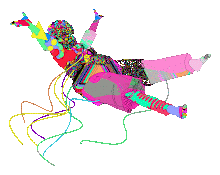 Credit: Cassini Imaging Team, SSI, JPL, ESA, NASA
Credit: Cassini Imaging Team, SSI, JPL, ESA, NASA20070926
iapetus
 Credit: Cassini Imaging Team, SSI, JPL, ESA, NASA
Credit: Cassini Imaging Team, SSI, JPL, ESA, NASA
eclipsed to death by
...and you will know us by the trail of dead
@
26.9.07
0
eclipses
![]()
tags: iapetus, saturn, spacecraft
20070902
ladies and gentelmans...blue gene
 The IBM® System Blue Gene®/P Solution is designed to operate continuously at speeds exceeding one “petaflop” - or one-quadrillion operations per second. The system is 100,000 times more powerful than a home PC and can process more operations in one second than the combined power of a stack of laptop computers nearly 1.5 miles high. Blue Gene/P can be configured to reach speeds in excess of three petaflops, a performance level that many thought unattainable only a few short years ago.
The IBM® System Blue Gene®/P Solution is designed to operate continuously at speeds exceeding one “petaflop” - or one-quadrillion operations per second. The system is 100,000 times more powerful than a home PC and can process more operations in one second than the combined power of a stack of laptop computers nearly 1.5 miles high. Blue Gene/P can be configured to reach speeds in excess of three petaflops, a performance level that many thought unattainable only a few short years ago.
The Blue Gene® line was born from a visionary IBM initiative to develop a hugely scalable and highly reliable scientific computing platform. With Blue Gene, designers sidestepped two key constraints on state-of-the-art supercomputing - power usage and space requirements. Blue Gene was purpose-built to fit in smaller spaces and use less electricity compared to other commercially available designs. Today, Blue Gene/P is at least seven times more energy efficient than any other supercomputer.The influence of Blue Gene’s super energy-efficient design and computing model -- once considered exotic - can be seen everywhere in the industry where people have attempted to lower energy use and get performance without traditional reliance on chip frequency. The breakthrough BlueGene design uses many small, low-power chips each connected through five specialized networks inside the system.
Like its predecessor, Blue Gene/P is a modular design, composed of “racks” that can be added as requirements grow. Four IBM (850 MHz) PowerPC® 450 processors are integrated on a single Blue Gene/P chip. Each chip is capable of 13.6 billion operations per second. A two-foot-by-two-foot board containing 32 of these chips churns out 435 billion operations every second, making it more powerful than a typical, 40-node cluster based on two-core commodity processors. Thirty-two of the compact boards comprise the 6-foot-high racks.
Each rack runs at 13.9 trillion operations per second, 1,300 times faster than today’s fastest home PC.The one-petaflop Blue Gene/P configuration is a 294,912-processor, 72-rack system harnessed to a high-speed, optical network. Blue Gene/P can be scaled to an 884,736-processor, 216-rack cluster to achieve three-petaflop performance. A standard Blue Gene/P configuration will house 4,096 processors per rack.
For more information, go to: blue gene
eclipsed to death by
...and you will know us by the trail of dead
@
2.9.07
1 eclipses
![]()
tags: supercomputer




